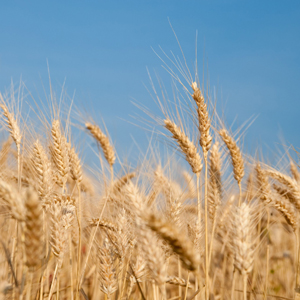
Lectins are sugar-binding proteins. In plants, lectins serve as a natural defense system to fight off mold and parasites.
by Mary Budinger —
One of the reasons grains may be such a problem to eat is because they contain lectins — in addition to gluten. Although gluten in wheat, rye and barley has gotten the headlines, lectins are a bigger problem, according to Sayer Ji, author of The Dark Side of Wheat.
Wheat found in bread today (triticum aestivum) is a far cry from the bread of Roman times. It has been genetically tweaked — not genetically modified, but aggressively crossbred and hybridized. And with all that hybridization, the gluten content of some varieties has increased by as much as 50 percent.
Wheat also contains a lectin known as wheat germ agglutinin (WGA). Lectins are sugar-binding proteins. In plants, lectins serve as a natural defense system to fight off mold and parasites. When plants sense an invader, lectins counterattack by binding to the foreign sugar molecules to stop the unwanted cells in their tracks. That is good news for the plants.
But when lectins get into your body, they are still programmed to attack sugar molecules. That is bad news for your digestive system, which is lined with sugar-containing cells that help you break down food. Lectins are drawn right to that lining, and your immune system retaliates.
Lectins are found in all foods, but in some more than others. All seeds of the grass family — wheat, rye, rice, spelt, etc. — are high in lectins. You also find lectins in beans, dairy and in the nightshades (tomatoes, potatoes, eggplant). According to a 1991 study, dairy may be potentially more harmful in pasteurized, processed milk because of the reduction of SIgA, an immunoglobulin that binds dangerous lectins.
A single, one-ounce slice of wheat bread contains approximately 500 micrograms of WGA. According to Ji, if it were refined to its pure form and injected directly into the blood it could in theory have platelet-aggregating and erythrocyte-agglutinizing effects strong enough to create an obstructive clot, such as what happens in heart attacks and strokes.
Lectins are not altered by digestive enzymes, and may alter gut permeability. Lectins circulate throughout the bloodstream where they can bind to any tissue in the body — thyroid, pancreas, collagen in joints, etc. This binding can disrupt the function of that tissue and cause white blood cells to attack the lectin-bound tissue, destroying it. This is an autoimmune response.
Ji states: “This may explain why chronic inflammatory and degenerative conditions are endemic to wheat-consuming populations. Like manmade pesticides, lectins are extremely small, resistant to breakdown by living systems and tend to accumulate and become incorporated into tissues where they interfere with normal biological processes.”
One way to gauge just how pervasive the adverse effects of these foods are among Western populations is the popularity of the dietary supplement glucosamine, used for reducing pain and inflammation. Ji writes: “When we consume glucosamine supplements, the chitin-binding lectins in our foods bind to the pulverized chitin (exoskeletons of crustaceans) in the glucosamine supplements instead of binding to our tissues, sparing us from their full impact.
Many millions of Americans who have greatly reduced their pain and suffering by ingesting glucosamine and NSAIDs may be better served by removing chitin-binding, lectin-containing foods (the underlying cause of their malaise) from their diets.”
WGA levels are not tested for, even in blood tests looking for antibodies against the various gluten proteins, so the lectin problem remains almost entirely obscured.
Why does wheat/rye/barley not noticeably bother everyone? And why is there no protection in nature from lectins? Those answers lie in the balance of gut flora and the integrity of your immune system.
When you have adequate beneficial floras, you have a protective barrier against substances that travel through the intestines, including lectins. And, beneficial floras keep the production going in the intestines of two lectin-protective substances, mucin and secretory IgA.
Source: Sayer Ji, GreenMedInfo.com; Dr. Al Sears; Davin JC et al., Biol. Neonate, 1991;59(3):121-5.
Mary Budinger is an Emmy award-winning journalist who writes about integrative medicine. 602-494-1999.
Reprinted from AzNetNews, Volume 31, Number 5, October/November 2012.





December 9, 2012
Chemical and Toxic Exposure, Food, Nutrition and Diet, Health, Health Concerns, Heart disease, Inflammation, October/November 2012 Issue